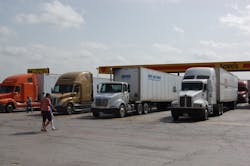A new white paper compiled by the American Transportation Research Institute (ATRI) indicates that truck driver demographic trends are rapidly approaching an alarming “cliff” as too few younger workers are on hand to replace a driver population rapidly approaching retirement age.
ATRI’s analysis of U.S. Census Bureau data found that the trucking industry is disproportionately dependent on employees 45 years of age or older, many of whom are expected to retire in the next 10 to 20 years, complicated by a simultaneous sharp decrease in the number of younger drivers, particularly those 35 and under.
“There’s not a lot of time between where we are now and the cliff,” Rebecca Brewster, ATRI’s president and COO, told Fleet Owner. “This industry has relied on a loyal cohort to stay behind the wheel because we as an industry still haven’t figured out how to backfill the [driver] population with younger folks.”
While this is not a new problem, Brewster argued that it is one rapidly reaching a tipping point of sorts as rising freight demand is colliding with trucking capacity limits. “Now however we have U.S. Census data to back this up,” she added.
ATRI’s white paper, written by Jeffrey Short, a senior research associate with the group, noted that while the U.S. labor market has nearly recovered from the Great Recession, employment gaps still remain.
Of the 155.9 million people in the U.S. civilian labor force, 146.9 million are employed and 8.9 million are unemployed – with 92.5 million additional persons not in the labor force, a figure that has grown by nearly 2 million people over the past year, according to ATRI’s analysis of Census data.
Out of the total U.S. labor pool, approximately 7 million persons hold trucking-related jobs with 3.2 million employed as truck drivers. With freight volumes on the rise, however, American Trucking Associations (ATA) data indicates that the industry is suffering a shortage of between 30,000 and 35,000 drivers right now, which could grow to 240,000 drivers by 2022 when aligned with freight growth forecasts.
“On average, trucking will need to recruit nearly 100,000 new drivers every year to keep up with demand for drivers, with nearly two-thirds of the need coming from industry growth and retirements,” noted Bob Costello, ATA’s chief economist.
On top of that, the U.S. Bureau of Labor Statistics (BLS) estimates that employment of heavy and tractor-trailer truck drivers is projected to grow 21% from 2010 to 2020 – faster than the average of all other occupations.
"The average age of our current driver workforce is 52 and we're noticing fewer and fewer younger individuals applying for jobs in recent years," noted Keith Tuttle, the founder of Motor Carrier Service, Inc. and a member of ATRI's research advisory committee, in a statement.
"If the industry doesn't collectively figure out how to recruit younger drivers, we may not have anyone left to haul freight in the coming decade,” he stressed. “With more and more of the nation's freight being hauled by trucks now and in the future, this is a piece of the puzzle we have to solve."
Short’s analysis indicates that perhaps the single biggest obstacle to enticing younger workers to become truck drivers is the federal requirement that interstate commercial driver’s license (CDL) holders be aged 21 or older.
“The resulting three-year post-high school gap precludes many from considering a career in truck driving,” he wrote. “There are additional institutional limitations on how old you must be to participate in certain sectors of the industry as well. Examples include hazmat or long-haul trucking, where 25 years of age is a common insurance-based expectation.”
Yet ATRI’s Brewster pointed out that other trends – particularly the rapid escalation of college costs and student loan debt – may help trucking companies start tackling that “gap” more effectively.
“This is where we need to make a point, particularly as the idea of the vocational education [path] is revisited across the country,” she explained. “From that standpoint, the industry needs to get more ‘irons in the fire’ in the vocational area, especially in high schools. We need to show that driving a truck is a great career option for them.”
About the Author
Sean Kilcarr
Editor in Chief
Sean Kilcarr is a former longtime FleetOwner senior editor who wrote for the publication from 2000 to 2018. He served as editor-in-chief from 2017 to 2018.
